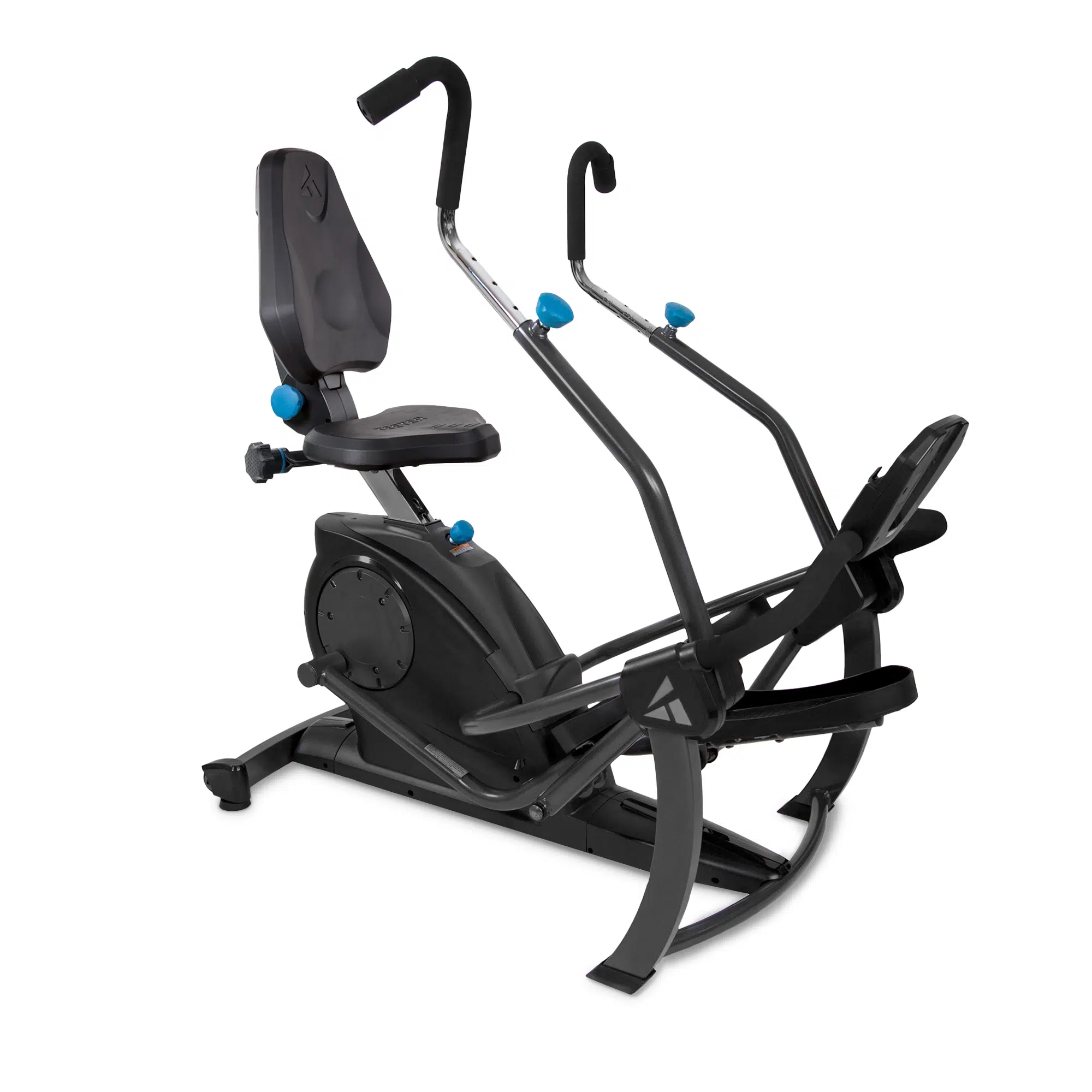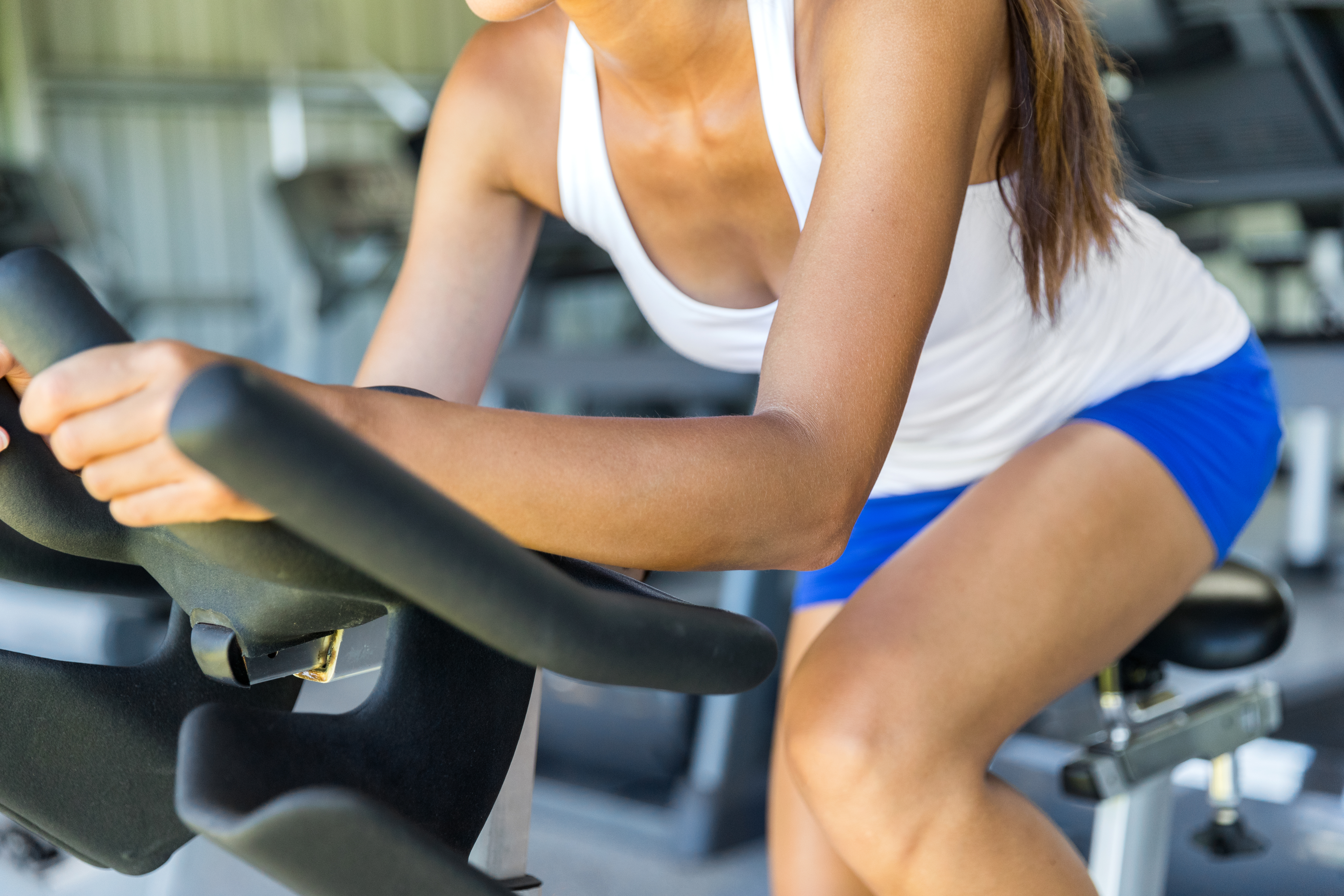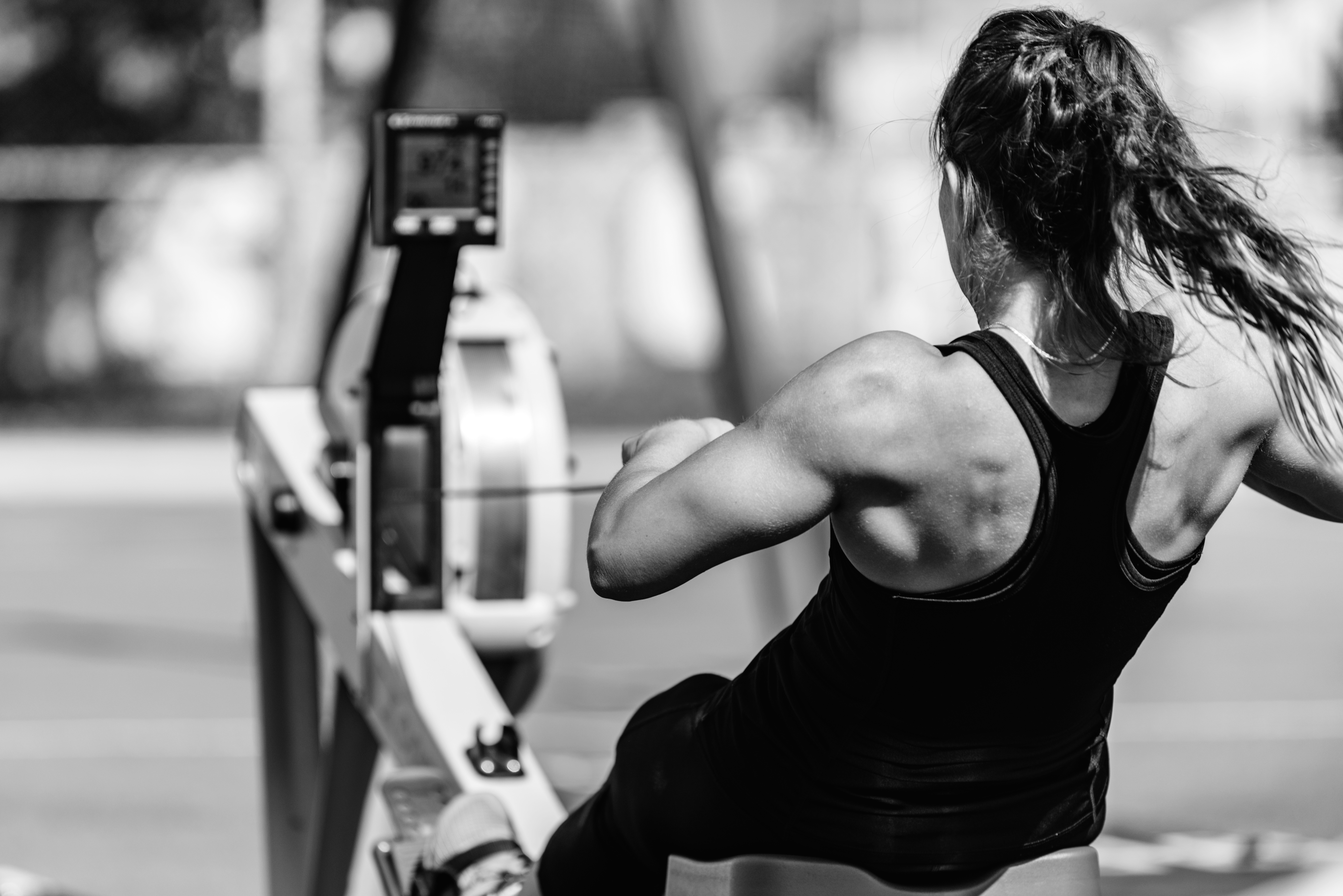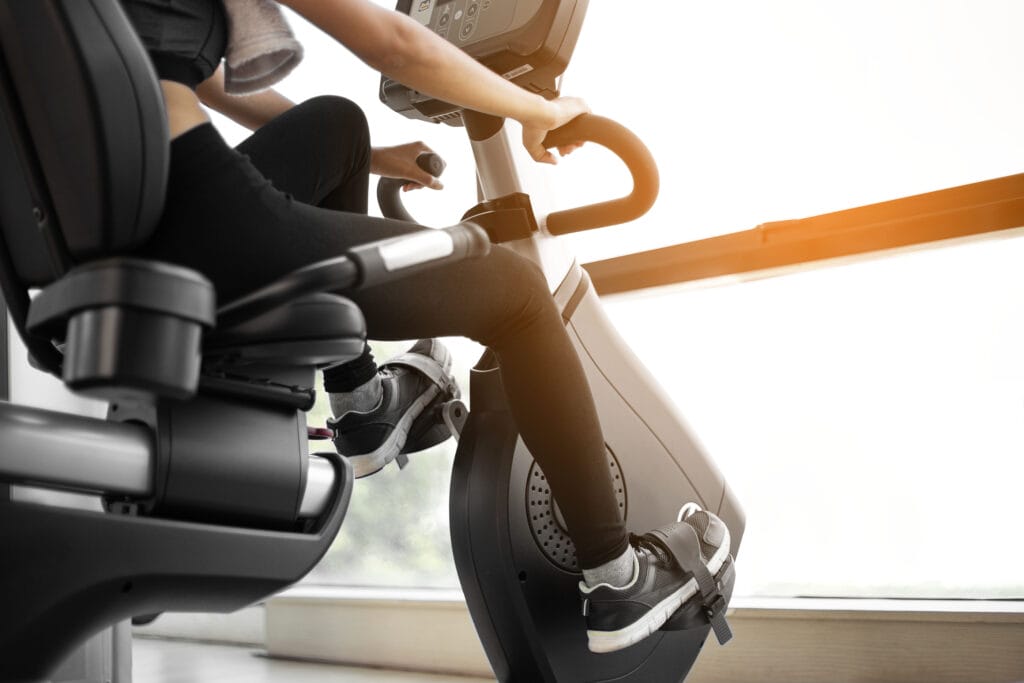
Achy joints can make it difficult to get the exercise we need and often results in folks becoming less active over time.
Which, ironically, can lead to stiffer, achier joints, thus making it even harder to exercise.
It’s a vicious cycle that can be hard to escape from, but we do have options.
Opting for a low impact cardio machine can make all the difference when it comes to exercising without aggravating achy joints.
It’s true – there are plenty of gentle, low impact exercise machines out there that take it easy on your knees and hips, but the key is knowing what to look for and where to find it.
Which is exactly what I’m here to help with.
As a physical therapist, I help folks dealing with all kinds of aches and pains find ways to exercise every day, so I promise you, there’s hope.
In this guide, I’ll go over the home exercise machines that offer the most joint-friendly workouts, but I’ll also discuss the features we should be looking for when comparing options.
After reading, you’ll know which machines will work best for your home (and your joints).
Recumbent cross trainers and recumbent bikes offer the lowest impact workouts, but ellipticals and even stair-climbers can be surprisingly joint-friendly as well.
The 9 Best Home Exercise Machines For Low Impact Workouts
#1 Teeter’s FreeStep LT3
Teeter’s FreeStep LT3 is an affordable recumbent cross trainer that’s easy to use and priced effectively for most budgets.
It’s actually one of the most affordable recumbent cross trainers I’ve ever come across (although Teeter’s LT1 is even more affordable).
Anyway, the LT3 doesn’t come with any fancy features, but it does offer a comfortable, very low-impact mode of exercise.
As a cross-trainer, you get the linear, pressing movement through the legs and the adjustable handles allow you to get your arms involved as well.
This machine comes with 13 resistance levels, giving you a decent amount of control over the intensity of your workouts, but the LT3 isn’t really designed for more strenuous workouts.
So, if you’re looking for a trainer that can provide higher resistances, this might not be the right fit for ya.
But the magnetic resistance system offers a smooth, quiet feel which is great for getting your joints moving.
It also comes with an adjustable backrest, a simple display, and a tablet holder that makes it easy to view your tablet while exercising.
And with a compact footprint (roughly 4.5′ x 3′), it’s easy to move and fit in most homes.
You’ll also notice that the seat is oriented more vertically, which makes it easier to access as well.
Overall, the LT3 doesn’t come with any advanced features, but as budget-friendly recumbent cross-trainers go, it’s the best. See full review.
#2 Sole’s LCR Recumbent Bike
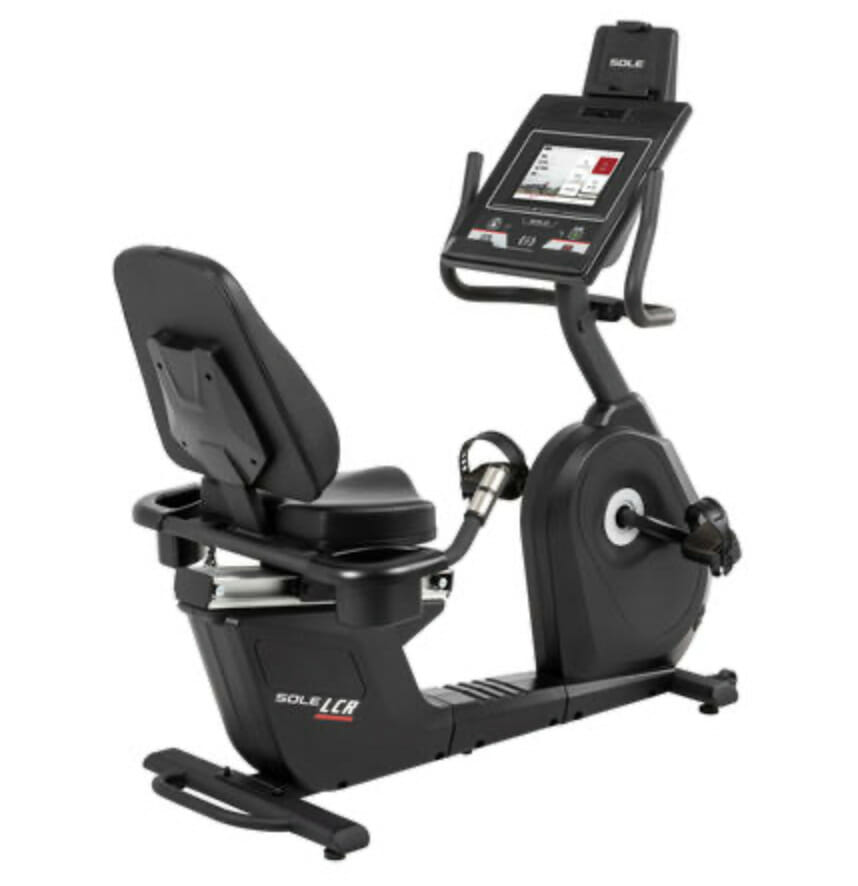
If you’re more interested in going the recumbent bike route, Sole’s LCR is worth considering.
With it’s impressive combination of performance specs and features, I think Sole’s LCR is easily one of the best home recumbent bikes on the market.
Especially for folks looking for a bike that can handle more resistance.
This recumbent bike comes with a 31 lb flywheel and 40 levels of resistance, making it well-equipped for providing a smooth pedaling motion and offering higher-intensity workouts.
But it also comes with a heavy-duty frame (~150 lb assembled) and a 350 lb weight capacity, giving it more of that commercial-grade feel.
The LCR is a high-performing recumbent bike, but it scores highly in the features department too.
Now that Sole upgraded its console, the LCR now comes with a 10.1″ touchscreen console with built-in entertainment apps (Netflix, Hulu, etc), screen mirroring capabilities, and access to Sole’s free workout streaming app.
There’s also plenty of traditional workout profiles if you prefer too.
And last, but certainly not least – Sole backs this recumbent with a great home warranty.
With an asking price under $2k, the LCR is well-priced for what it offers, but if you’re simply looking for a gentle, smooth ride, it may be more bike than you need (in which case you might want to check out Sole’s more affordable R92).
But if you’re looking for a smooth-acting recumbent bike with loads of features, the LCR is a great choice. See full review.
#3 Sole’s E95 Elliptical
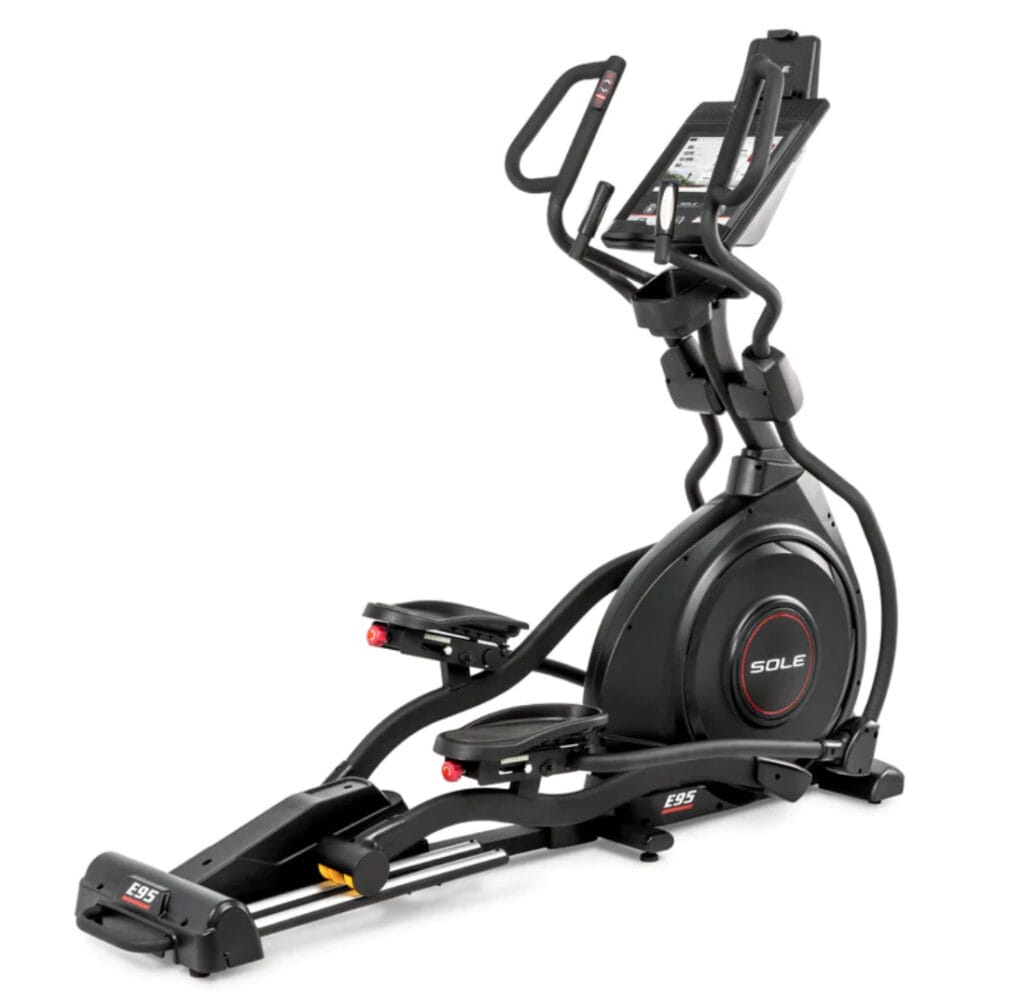
The E95 is one of Sole’s mid-range ellipticals and as such, it comes with a lot of great stuff.
When it comes to performance, this elliptical is equipped with a heavy flywheel (27 lb), plenty of resistance levels (20), and a large range of incline capabilities (20 levels).
The frame is robust, weighing well over 200 lb, so you can expect a rock-solid feel while workouts.
And with a 400 lb weight limit, folks of all sizes can safely use this machine.
The smooth acting magnetic systems makes for a low impact feel during use, but Sole also designed the E95 with adjustable pedals for an even more comfortable experience.
With Sole’s “worm drive” you can make micro-adjustments to the angle of each pedal, fine tuning where you want them for optimal comfort.
It’s a great feature, especially for folks prone to ankle/foot pain.
The E95 comes with a 13″ version of Sole’s touchscreen consoles, giving you access to all the same goodies mentioned earlier (entertainment apps, screen mirroring, streaming workouts, etc).
And with a lifetime frame, 3 year parts guarantee, you’ll be able to rest assured that the E95 is designed to last.
Overall, if you’re looking for a low impact elliptical with additional comfort features, Sole’s E95 is worth checking out. See full review.
#4 NuStep’s T4r Recumbent Cross Trainer
NuStep created the first recumbent cross trainer and they’re still putting out some of the finest options on the market.
And even though NuStep is likely known more for their commercial-grade trainers, which are often found in rehab facilities and commercial gyms, they do offer a residential lineup as well.
Speaking of which, the T4r is their entry-level trainer, but it’s still more sophisticated than most competitors.
The T4r offers one of the lowest-impact movement patterns available, allowing the user to control their step length during workouts to stay within their pain-free range.
And with a very low starting resistance, the T4r is designed to work with even the most sensitive joints.
The T4r also comes with a wheelchair height, swiveling seat that makes it easy to access for users of all mobility levels and the comfy backrest and included armrests ensure comfort and safety during use.
I’ve personally worked with several patients that were lucky enough to have these in their homes and I’ve never heard a single complaint.
NuStep is awesome, but this greatness comes at a cost – with an asking price starting around $4k, the T4r is going to be outside a lot of people’s budgets.
But if you have the means and are looking for a low impact fitness machine that can accommodate folks of any mobility level, NuStep’s T4r could be a great choice.
#5 Schwinn’s 290 Recumbent Bike
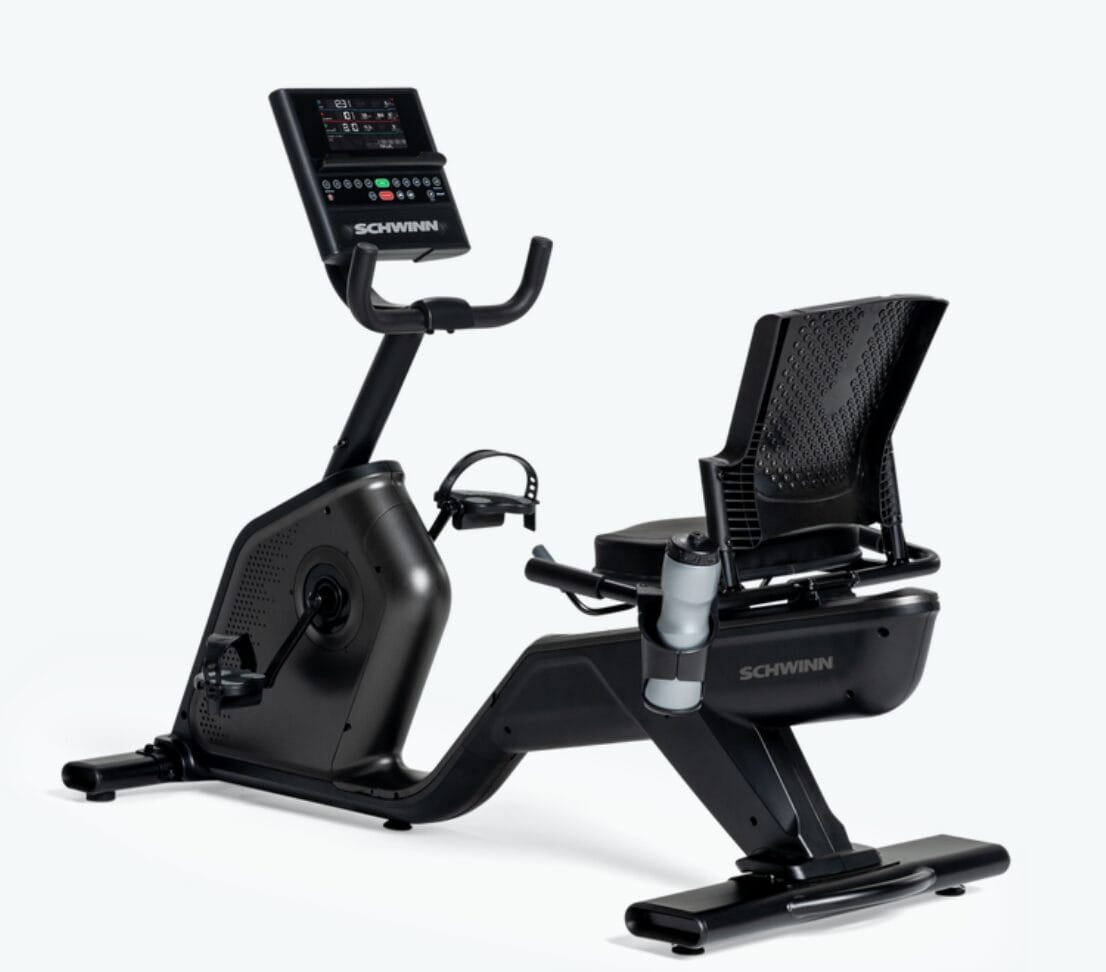
The 290 is Schwinn’s newest recumbent bike to date and it comes with a new, sleek frame design and an updated console.
There’s nothing too fancy going on here, but if you’re looking for a low impact ride that won’t break the bank, the 290 is a great choice.
With only an 8 lb flywheel, the 290 isn’t as high-performing as the LCR mentioned earlier, but it still comes with 25 resistance levels, giving you a lot of control over your workouts.
The step-thru frame makes it easy to get on/off of from either side and the impressive 330 lb weight limit allows it to safely hold riders of all sizes.
The console is large and brightly-lit, making it easy to see all your workout stats and it’s also bluetooth compatible with fitness apps.
And with 13 built-in workouts to choose from, you’ll have plenty of workout options at your disposal as well.
Schwinn’s warranty on this recumbent is surprisingly good too for price range: 10 year frame, 2 year parts, 90 day labor.
Overall, the 290 doesn’t come with amazing performance specs or an overly-sophisticated console, but for the price range, it’s gonna be hard to find a more comfortable ride. See full review.
#6 The STEPR+

The STEPR+ is a compact stair climber machine designed specifically for home use and I think it’s one of the coolest cardio machines to hit the market in a while.
And even though stair climbing and low impact don’t always go together, hear me out on this one.
The STEPR+ uses 5.2″ high stairs, which are considerably lower than the 7-8″ stairs found in home staircases, making them a lot easier to ascend.
These are the kind of stairs you’d find in a sports stadium, fyi, so they’re designed to be easier to access.
Anyway, the lower stair height makes the STEPR+ lower impact than most and personally, I find it very comfortable to use.
The elongated safety rail encompassing the front offers tons of handle options for added safety and the conveniently-placed emergency stop buttons ensure you can stop it easily whenever necessary.
There’s also a sensor at the bottom that stops the machine automatically in case a foot or other body part accidentally finds itself beneath the stairs.
The STEPR+ offers smooth acting stair action with speeds ranging between 24 – 137 steps per min, so it can challenge users of all skill levels.
There’s also a jumbo, 27″ HD touchscreen console mounted front and center that gives you access to instructor-led workouts, built-in entertainment apps, metric tracking, and more.
Personally, I love to watch movies on Netflix while stepping, but again, there’s tons of options here.
The biggest downside is the price, but if you’re looking for a unique, low impact cardio workout, the STEPR+ could be just what you’re looking for. See full review.
And you can get a free 36-month extended warranty with the promo code: “THEHOMEGYM”
#7 Horizon’s 7.0 AE Elliptical
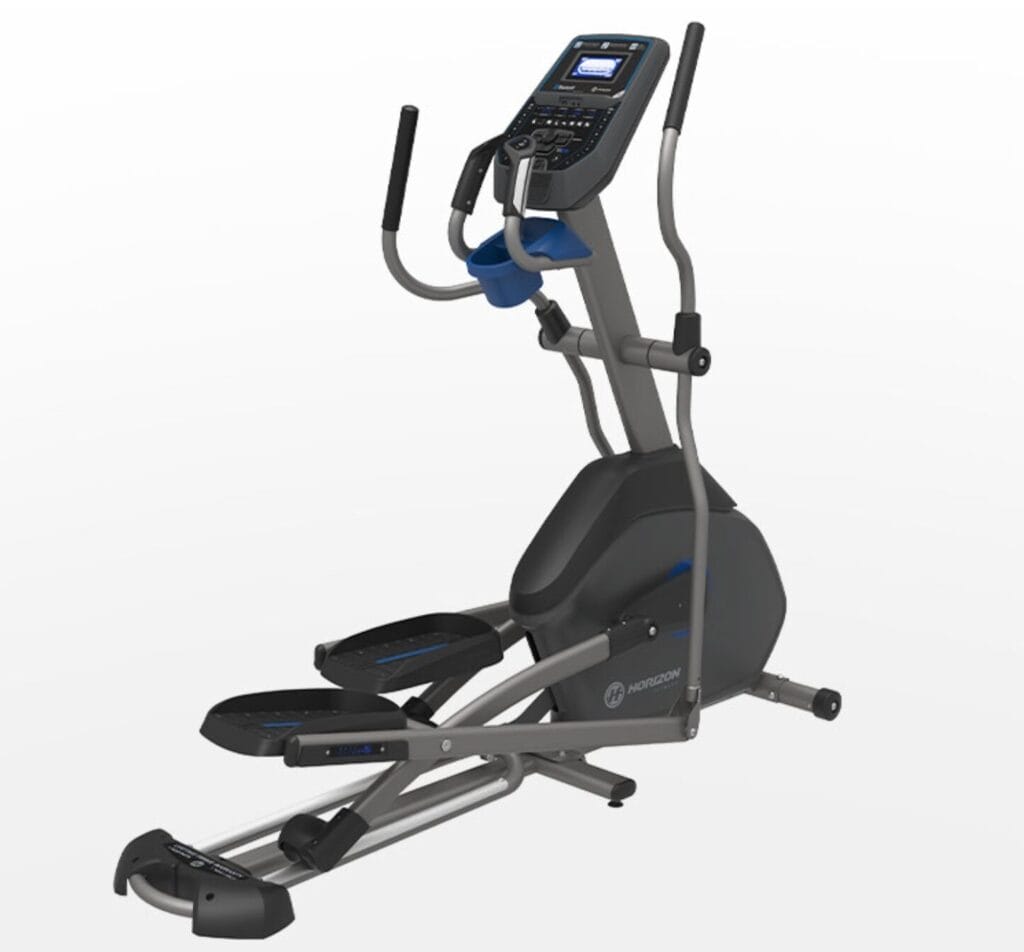
Horizon’s 7.0 AE is an affordable elliptical with a lot to offer for the price range.
I consider Horizon to be one of the best home brands in the game and even though their lineup isn’t that big, everything they offer is well-built and backed by nice warranties.
Anyway, the 7.0 AE doesn’t come with many fancy features, but it does provide a smooth pedaling motion and it comes with some great performance specs for a $1k elliptical.
More specifically, this elliptical comes with a 23 lb flywheel, 20 levels of resistance, and 20 levels of incline.
It also comes with a comfy, 20″ stride length that’s long enough to accommodate most users comfortably.
This elliptical also has a robust frame and a 325 lb weight limit, again, both of which are impressive for this price range.
The console isn’t overly tech-savvy, but it does come with a handful of built-in workouts, bluetooth speakers, and bluetooth compatibility with fitness apps.
The biggest downside is probably the 10″ step-up height, which may be a little high for folks with really achy knees.
But if you can comfortably ascend stairs, you’ll likely be fine getting on/off this machine.
Oh, Horizon’s warranty here is pretty good too – they back the 7.0 AE with a lifetime frame, 3 year parts, 1 year labor warranty.
Otherwise, if you’re looking for a well-priced elliptical with some great performance specs, Horizon’s 7.0 AE could be a good fit. See full review.
#8 Spirit’s CRS800S Recumbent Stepper
The CRS800S is another high-end recumbent cross trainer and it’s priced similarly to NuStep’s T4r mentioned above.
Spirit’s a great brand, known for their heavy-duty machines and great warranties, and their CRS800S is a quality cardio machine.
I’ve actually come across this stepper a few times in light-commercial settings (adult living clubhouse gyms), which in itself speaks to its quality.
Anyway, the CRS800S is a heavy-duty trainer with all the features you’d expect from a machine in this class.
This stepper comes with large pedals, easily-adjustable, multi-grip handles, a 360° swivel seat for easy access, included arm rests, and 20 levels of smooth acting resistance.
There’s also an easy to use console with a few built-in workout programs, a cooling fan, and a USB charging port that’ll keep your tablet charged during workouts.
Spirit also backs the CRS800S with a great home warranty: lifetime frame, 10 year parts, 2 year labor (as well a light-commercial warranty).
Like NuStep, the biggest downside is the price – with a starting price of around $4k, this cross trainer isn’t cheap.
But if you’re looking for a commercial-grade, low impact cardio machine that should last forever, it’s a great choice. See full review.
#9 NordicTrack’s Commercial R35
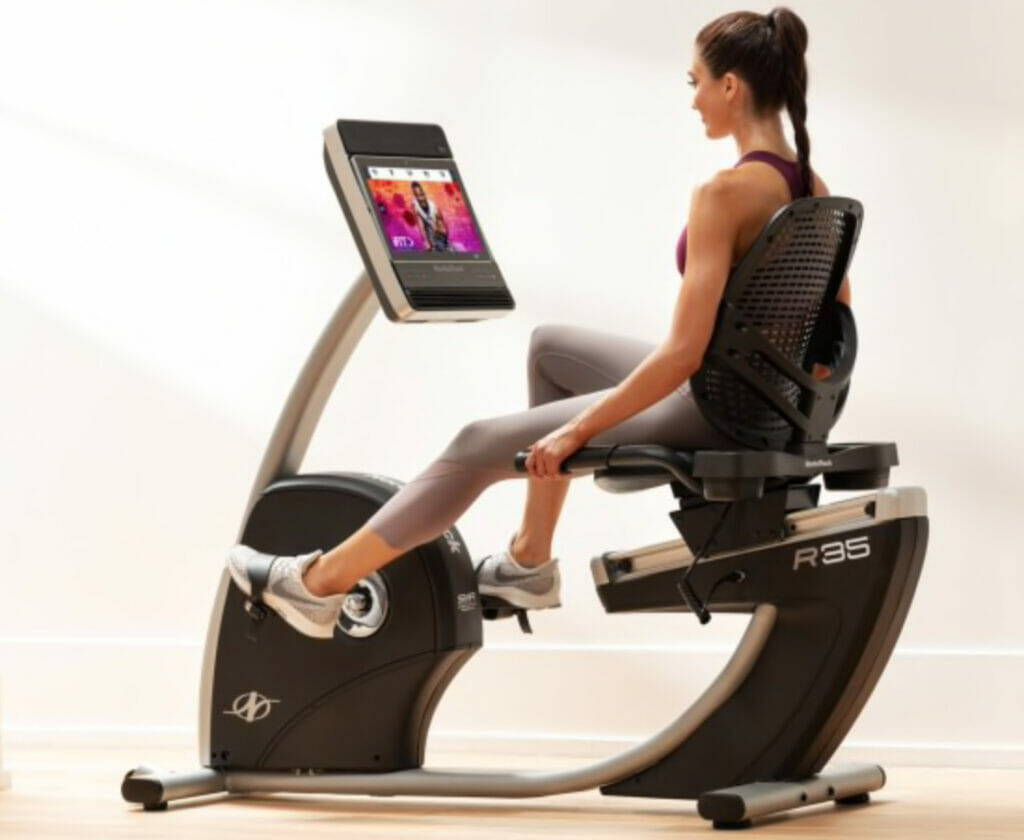
Rounding out my list here is another quality home recumbent bike with some great features.
NordicTrack’s one of those brands that we’re all probably familiar with and they’ve been one of the most popular fitness brands for a long time now.
These days, they’ve gone all-in with fitness streaming and their iFit app, but their products usually come with solid performance specs too.
That said, the R35 is best-suited for people interested in using iFit, so if you’re not, you’ll probably want to consider other options.
The HD touchscreen console is impressive, but the R35 also comes with a 25 lb flywheel, 26 resistance levels, large pedals, a comfortable seat, and a 350 lb weight limit.
The low, step-thru frame also makes for easy access and the heavy-duty frame makes for a stable machine that won’t feel flimsy during workouts.
NordicTrack doesn’t offer the best warranties out there, but with a 10 year frame and 2 year parts warranty, the R35 is pretty well covered.
Again, if you don’t want to pay for an iFit membership, the R35 probably isn’t the best option for ya, but if you like the idea of having instructor-led workouts and all those features, the R35 is a great recumbent bike.
Easily one of the best in its class. See full review.
What Makes An Exercise Machine “Low Impact”?
“Low impact”, “joint-friendly”, and “gentle on the joints” all refer to an activity or exercise machine that takes it easy on your joints.
Meaning, more specifically, that people with arthritis or sore joints should be able to use ’em with little to no discomfort.
And yes, people with arthritis should still be exercising because it can help improve strength, reduce pain, and maintain joint mobility.
Anyway, we could even take this one step further and think about how some exercises/equipment create more impact forces through your knees, hips, and ankles.
Joint impact is usually greatest during activities that involve your feet leaving the ground – think walking, running, jumping, etc.
Anytime your foot leaves the ground, it’s going to have to return, creating a force from the ground that travels up your leg and through your joints and soft tissues.
And these forces can be quite large, depending on the activity.
Running, for example, is the complete opposite of low impact – it’s been estimated that the force going through your foot at initial contact can be as high as 4 – 7x your body weight…
Wow.
Conditioning yourself and working on proper technique can help your body handle these higher stresses, but even healthy joints can develop issues trying to deal with these higher-impact activities.
Considering this, it’s no wonder people with arthritis tend to have pain with running.
Luckily, there are other ways to exercise that put a lot less stress through the joints – that is, exercises that are low impact.
We’re here to talk about low impact exercise machines specifically, but I do want to mention that swimming is one of the lowest impact exercises out there.
The water helps reduce any impact force from your foot hitting the bottom and of course it also reduces the amount of gravity you have to fight against.
In other words, swimming is a very joint-friendly mode of exercise, regardless of which joints are effected.
But when it comes to low impact exercise machines, recumbent cross trainers, recumbent bikes, and ellipticals are likely your best bet.
And I’d put them in that order in terms of lowest impact machines.
Recumbent Cross Trainers
If you combined a recumbent bike and a stepper machine, you’d get a recumbent cross trainer.
These cardio machines are as low impact as they come, which is why you’ll usually see them in rehab facilities, assisted living facilities, adult living gyms, and any other environment where people with arthritis may be exercising.
These machines are so low impact for a few reasons.
For starters, you’re sitting instead of standing, which immediately reduces any potential impact through your knees and hips.
Standing (weight bearing) immediately increases the weight/stress going through your joint, so folks with really sensitive joints will likely do better with a seated (non-weight bearing) activity.
Recumbent cross trainers also tend to put you in a more horizontal position, where your legs are out in front of you instead of beneath you.
This, combined with the stepping motion, puts little pressure through the knees and hips.
This stepping motion is even a little lower impact than the circular motion used on recumbent bikes, so people with even advanced arthritis can often use recumbent cross trainers comfortably.
The nicer cross trainers will allow you to control how far down you push the pedals too, allowing you to remain without a pain free range of motion the entire time.
Recumbent Bikes
Recumbent bikes, like cross trainers, also put you in a seated, horizontal position, which immediately makes for a pretty low impact activity.
The cycling motion a recumbent bike uses is also low impact in nature, but again, the rotational aspect of this movement can be aggravating to overly stiff or sensitive joints.
I’ve had a few patients in the past that couldn’t tolerate recumbent biking, but were able to tolerate recumbent cross trainers.
Something to consider if you’re dealing with high pain levels.
Recumbent bikes don’t usually come with the mobility aids found on cross trainers as well.
Swiveling seats, arm rests, and adjustable, moving handles tend to give recumbent cross trainers a slight advantage over recumbent bikes when it comes to overall low-impactness (I think I just made that word up).
But recumbent bikes are a lot more affordable, so there’s that.
Ellipticals
Elliptical machines keep you in a standing position, so they’re immediately a little higher-impact than recumbent cross trainers or bikes.
But your feet don’t leave the pedals on an elliptical, so they’re still very low impact compared to walking or running on a treadmill.
Ellipticals are also paired with magnetic resistance systems that make for smooth operation, plus you can use your arms to help propel the pedals as well.
If you don’t have joint pain walking on the ground, you’ll likely be able to use an elliptical comfortably.
Because of their low impact nature, ellipticals make great options for people who may not be able to use a treadmill comfortably, but aren’t necessary dealing with severe joint issues.
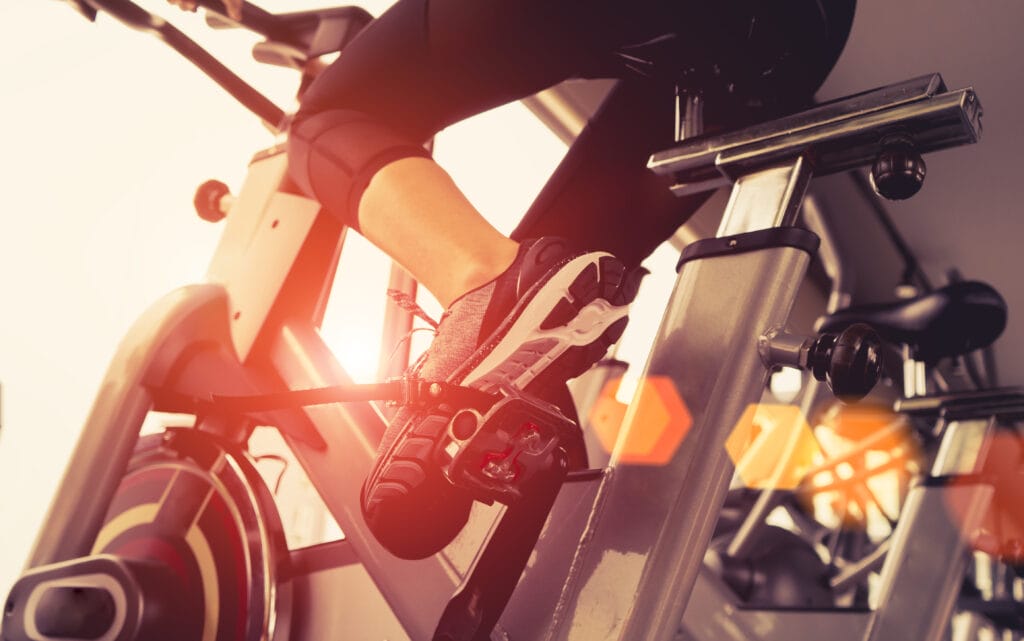
Are Indoor Cycles Low Impact?
Personally, I’d say yes, I think indoor cycles are fairly low impact because you’re non-weight bearing and your feet never leave the pedals.
This means, technically speaking, there shouldn’t be a ton of impact forces traveling through your joints.
That said, indoor cycling isn’t as low impact as the machines discussed above.
For starters, when you’re sitting on an indoor cycle, your legs are directly beneath you, putting you in a more vertical position.
This tends to increase the amount of knee flexion occurring as you pedal, meaning you need more range of motion to complete this kind of exercise.
Indoor cycling is also designed for a higher intensity workouts.
When cycling, you’re often working against higher resistances and pedaling at faster cadences, both of which put more stress through your knees.
Especially if you crank that resistance up really high and stand up.
This doesn’t mean people with arthritis can’t comfortably use an indoor cycles, it just means you’ll have to be careful.
If your joint issues are more severe, I’d suggest going with one of the lower impact machines already mentioned.
Final Thoughts
When it comes to low impact exercise machines, we actually have a lot of options to choose from.
And our lowest impact options, in this order, are:
- Recumbent cross trainers
- Recumbent bikes
- Ellipticals
Our options for recumbent cross trainers are more limited, but when it comes to home recumbent bikes and ellipticals, we have a ton of options to choose from.
And there are a lot of great recumbent bikes and ellipticals that I could’ve mentioned on this list, but I wanted to include options that were well-priced for home use.
Even so, it was really hard narrowing this list down to only 9 machines.
When comparing bikes and ellipticals, make sure to pay attention to those performance specs and keep in mind that having a heavier flywheel is a good thing when it comes to smooth pedaling action.
The stride length is another important spec to look for when comparing ellipticals and even though a 20″ stride is great for most folks, shorter users or folks looking for less range of motion might actually want to go with a shorter stride.
If you’re interested in learning more about what specs to look for when comparing recumbent bikes or ellipticals, check out my full guides for more info (links above).
Regardless of what kind of equipment you go with, know that exercise, in general, is a great thing for arthritis and stiff/achy joints.
The key is keeping those joints moving in a comfortable range.
Anyway, I think that about does it.
If you have any questions or comments, please leave ’em below and I’ll get back to you shortly.
